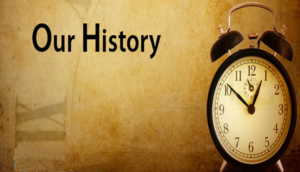 There has been some debate recently about whether or not we should use textbooks to teach history in secondary school. And, if we should use such books, which one should be the ‘core’ text, the one that might provide the backbone of a school’s KS3 history course.
There has been some debate recently about whether or not we should use textbooks to teach history in secondary school. And, if we should use such books, which one should be the ‘core’ text, the one that might provide the backbone of a school’s KS3 history course.
Let me start with the disclaimer: I don’t have a problem with textbooks. I’ve been involved in writing two of them. I have a massive collection of schools history textbooks that I have acquired along the way.
Over the 20 or so years of my teaching career they are my first port of call when I want to find out about or plan a new series of lessons. I have enjoyed teaching with a number of different books, and I have written to their authors to tell them how great their works are.
The Think Through History series did more than give the substantive knowledge I needed to get over to my classes. It actually gave me a pedagogical methodology with which to teach them. It served as a professional development tool. It showed me how a clever approach raised standards dramatically.
However, the problem I have with using a ‘core’ text to act as a backbone of KS3 history course is that it, taken to the extreme, challenges my view of what schools’ history is. I do not want to teach ‘heritage’ as defined by David Lowenthal: ‘the use of the past to support or oppose interests in the present.’
History is and should be not a weapon used by one group against another.
What kind of history do you want to teach?
Recently I have been attempting to extend my anglo-centric knowledge of the teaching of historical interpretations a little wider.
In Beyond the Cannon: History in the 21st Century Peter Sexias states that there were three possible approaches to answer the question: ‘which story of the past should we teach?’
- The collective memory approach: tell the one agreed story of the past. Curriculum designers, textbook authors etc would agree what that story is and then teach this grand narrative, potentially through a core textbook. (Heritage not history).
- The disciplinary approach: give the students the tools to critique different accounts of the past, examine the evidence base of each account and assess the relative strengths and weaknesses of each interpretation.
- The postmodern approach: similar to the disciplinary approach in presenting the idea of competing narratives of the past, but going one stage further: acknowledging that the problem of competing narratives is not just about analysing the evidence base on which each was constructed upon, but also acknowledging the fact that each account was also influenced by the political / ideological / religious / cultural context in which it was created. And, that students should be given the tools to unpick all of this so they can see that different narratives may serve different political or ideological purposes.
I am proud to say that I believe in the third of Sexias’s options. This is what lies at the heart of schools history to me. Ever since the invention of the National Curriculum for History with the inclusion of Historical Interpretations, this is what I have been trying to help my students to grasp. I am not sure that I realised this when I started out as a teacher way back in the 20th century, but on reflection this has been the thrust of my approach.
For sure we need to give our students an historical framework of the past and allow them to locate themselves and events within time. And we need them to focus equally on all of the second order concepts. We should design our curriculum with all of this plus more in mind.
The role of contextual knowledge
And don’t get me wrong it is also crucial to give students the substantive knowledge they need to help them make sense of the past. After all how are they going to make sense of different interpretations without some firm contextual knowledge? But, if we don’t ask our students to apply this knowledge then we are not really teaching the discipline of history just to learn lists and collect facts.
Cognitive Scientist Daniel Willingham himself makes this point in Why don’t students like school. He argues that:
‘Teachers should not make the importance of knowledge to mean that they should create lists of facts for students to learn…knowledge pays off when it is conceptual and when the facts are related to one another, and that is not true of list learning.’
Perhaps an argument agains the use of ‘knowledge organisers’?
What could be more conceptual than applying substantive knowledge to challenge and assess different interpretations of the past and to really see why an interpretation was actually created?
In my mind helping students to see this makes the history teacher’s role unique.
If our role is partly about getting students to really grasp how and why historical interpretations are formed, why do many history teachers find teaching this second order concept so tricky? It is quite interesting to see the number of workshops at National Conferences focusing on this interpretations rise again, after years of neglect.
Hmmm, perhaps its inclusion as AO4 in the 9-1 GCSE specs has got people in a bit of a tizzy.
What do some teachers think about the teaching of interpretations?
I did my own little survey amongst 20 or so teachers about the teaching of this concept recently. No strong conclusions can be drawn etc but it was interesting to see that the majority of teachers involved (60%) seemed to mainly focus their teaching on hero / villain style questions (not really heavy interpretations work). And, depressingly, at KS4 most (73%) seemed to be spending their time getting classes to jump through the hoops of the exam and teaching them how to answer the interpretations questions on the test. Follow up interviews with eight teachers confirmed this was the case.
Surprising? No.
Disappointing? Yes.
By the way it would be great if you could have a go at filling in the survey on your perceptions of how well interpretations are taught in your school, just click on this link: https://goo.gl/forms/0B0rcGBrSL8bzHPI2
‘But interpretations are too hard for KS3 kids’
There is a school of thought, that argues that KS3 students are not yet well equipped with the basics to be able to handle the more sophisticated thinking needed to approach the different elements of interpretations. I have even seen examples of KS3 curricular with interpretations completely missing. I strongly disagree with this approach.
15 years of my own classroom research in council estate comprehensives tells me that this isn’t simply the case. My classes have for example, strongly argued how why they think Browning or Goldhagen’s interpretation of Battalion 101 is more convincing, after considering the purpose and context of both accounts. Year after year we discussed in detail how and why Eisenstein’s ‘masterpiece’ October, must be viewed through the time in which it was created. I could go on… Because of all of this work their old school Paper 2 scores were always abnormally high. We did’t spend too much time focusing on examination technique but we did spend a hell a lot of time across five years bumping into many different historical interpretations.
If my own eight year old son can tell me that people don’t show their true selves on Facebook because they edit themselves by only showing their good side (his words), then lower secondary school children can definitely get to grips with how, why and in what context interpretations are formed. Don’t believe those who are propagating a substantive knowledge only agenda.
Instead ask yourself why you teach history and where do you stand when it comes to Sexias’s three options above? Does your teaching reflect this?
The next blog will give examples of how to teach interpretations across KS3.




